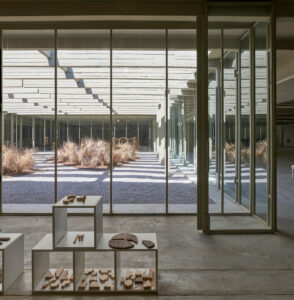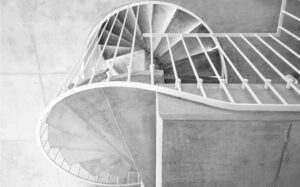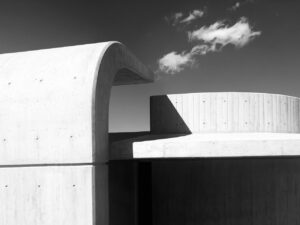EAST Architecture Studio is a collective practice committed to architectural design and experimental research.

Founders © Copyright 2023 - East Architecture Studio - Tarek Moukaddem
Based in Beirut, the studio has a strong focus on innovation and modern environments that it brings its unique touch. Founded by architects Charles Kettaneh and Nicolas Fayad, the studio works on projects of various scales ranging from master planning to interior design and adaptive reuse, engaging both contemporary society and traditional culture. The firm operates as an open laboratory continuously in search of new architectural typologies that reconsider the intersection between spatial experience, form, and technology while adjusting to changing social, economic, and political environments.
With the architecture industry at a crucial point of growth, there are many exciting projects on the horizon. Emphasis on history, culture and territory is an integral part of the Studio’s adopted design methods, defining an architectural response that engages with the challenges of our time. Along with a growing team of talented architects, partners, and consultants, the practice is constantly evolving in the shifting landscapes of modern life. Here we find out more about the Studio and what’s in the pipeline for the coming year.

Tell us a little about how East Architecture Studio came to life and where it is at today.
East Architecture Studio is a collective practice founded in 2015 focusing on architectural design and experimental research led by architects Nicolas Fayad and Charles Kettaneh. With projects ranging from master planning to interior design and adaptive reuse, the studio gained international recognition in its early days after winning major design competitions for large-scale developments in Africa and the Middle East. Last fall, the studio was announced as the winner of the Aga Khan Award for Architecture for its 2022 cycle.
What is your vision for the company moving forward?
The studio operates as a boutique architectural office yielding projects of multiple scales. This is in part due to a communal effort nurtured by a dedicated team of architects, collaborators and visionary clients with whom we share a joint vision for building a better future. We like to carry that joint spirit while exploring new territories, staying true to our design ethos regardless of the nature of the project.

You were recently awarded the prestigious Aga Khan award – tell us about this.
The Aga Khan Award for Architecture is given every three years to projects that set new standards of excellence in architecture, planning, historic preservation and landscape architecture. The Award seeks to identify and encourage built projects that successfully address the needs and aspirations of societies across the world, in which Muslims have a significant presence. Our project, the Renovation of Niemeyer Guest House, located at the Rachid Karami International Fair of Tripoli, North Lebanon, is one of the six winners of this year’s award. Our intervention was particularly commended for its social relevance in the context of Tripoli, as well as its sensitive renovation approach and its timelessness, as it sets out a relevant benchmark for the renovation of modernist heritage buildings in the region and in the Fair in particular.
What does it mean to you for your work to be recognised on an international scale?
We couldn’t be more honoured with this recognition. It comes with immense responsibility and great pride in equal measure. It also demonstrates that successful architecture comes in many different forms and that from great constraints intricate and surprising architectural responses can emerge.

How would you define your style of architecture?
Rather than defining our work stylistically, we opt to embrace specificity with every project that comes to the studio. We engage with these specificities in a contemporary way while being mindful of local cultures and construction techniques, bridging history with modernity.
It seems more than ever the lines are blurring between architecture, interior design and construction – where do you stand on this and how do you think the industry has changed?
Historically, there were never any boundaries between architecture, interior and construction, it has always been a holistic endeavour. We believe in that approach of envisioning spaces that operate in that way. In addition, the intricacies and complexities of a given construction technique create a very specific set of three-dimensional behaviours, materiality and applications. This directly informs the architectural qualities of a space, be it interior or exterior.

Where does sustainability fit into your business model and how has this changed the way you work?
We are very sensitive to the local specificity of the projects we work on. Our studio relies on applied research when it comes to construction methods that borrow from the past while embracing innovative building techniques. This focus on local resources and techniques goes a long way in promoting sustainable development and is embedded culturally in our part of the world. We embrace it, as it has always been a primordial aspect of our design process.
What is a project you are particularly proud of?
We are currently completing a gallery and private residence for an art collector. A capsule retreat that surges from a process of truly listening to the aspirations of its owner. The decisions behind its form and materiality are rooted in the interpretation of the local building culture, an assemblage of fair-faced concrete and local stone. The result follows this premise, an introverted shelter in close contact with its environment.
What do you consider when taking on a client?
Architects are listeners, and with every client comes a story. Our role is to envision a narrative, or an imaginary construct through our own design principles. When given this liberty for interpretation, clients allow architects to believe in the progress and push the boundaries of architectural knowledge. This exchange is crucial through early conversations with a prospective client.

What do you say no to?
We believe that every challenge hides opportunities that could offer unique possibilities for architecture. We do not reject but hold on to those challenges, because we know that the best projects come out of a complex process of negotiation.
How would you assess the architecture industry in the Middle East today?
The Middle East has become an epicentre for cultural production in an emerging new world. Giving shape to the region is a complex endeavour. Its character is rooted in the past, while its mind is set towards the future – a truly exciting time for architects and makers.
How do you get inspired?
As designers in today’s complex world, it is vital to acknowledge tradition, values, and beliefs but to also project ourselves into the future. We are very much inspired by contexts that have been shaped by history and time and like to carry our findings throughout every design project. In parallel, we heavily seek inspiration in the art world, through concepts that have become our own design principles.

What is in the pipeline for East Architecture studio for 2023?
2023 holds many exciting projects. On the drawing board is a commercial tower for the Kuwaiti quarters of Al-Qibla as well as a private home tucked in the coniferous hills of Mount Lebanon. Some of our construction sites are reaching their finishing stages, waiting to be revealed and lived. We always look forward to witnessing our clients appropriating their spaces, it’s always a very rewarding moment for everyone. Other planned events include the curation of a national ceremony for the Aga Khan Award for Architecture, and a book launch co-edited by our studio on the urgency of preserving our modern heritage. The year will also be interspersed with a series of lectures and symposiums around the theme of architecture, culture and contemporary society.















